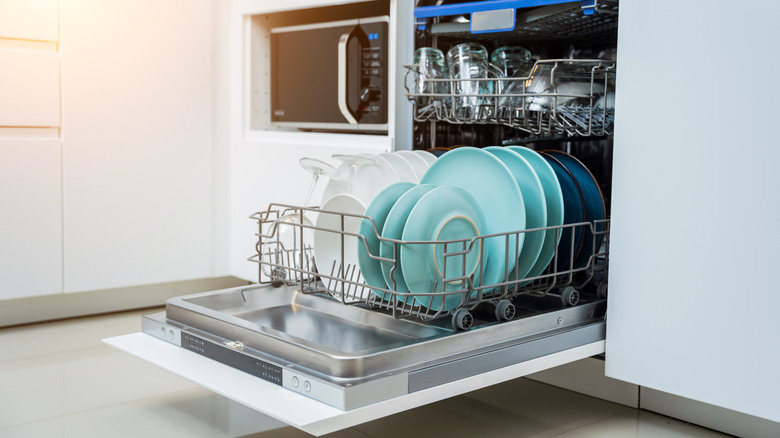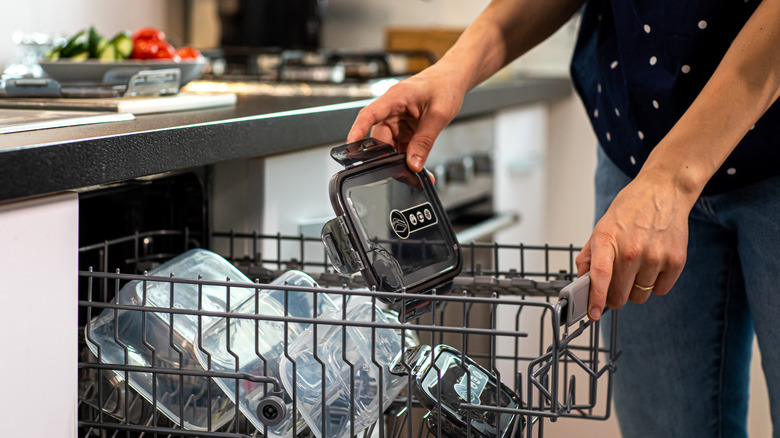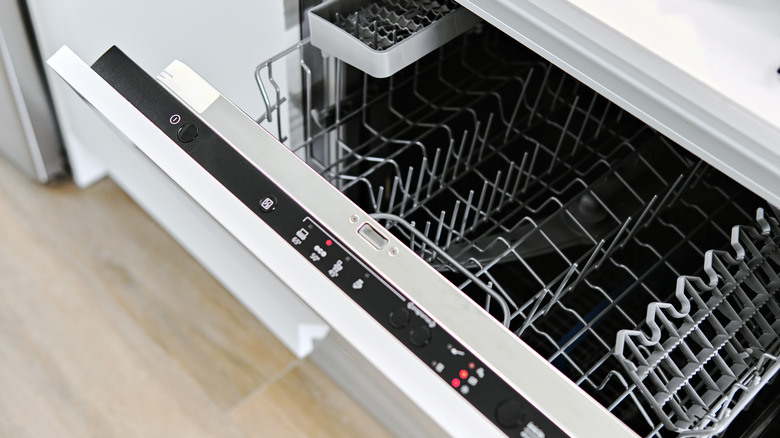5 Ways You're Still Loading Your Dishwasher Wrong
The dishwasher might be one of the greatest time-saving appliances in your home, but it's not always as simple as tossing in dishes, pressing start, and walking away. In fact, many of us unknowingly make mistakes that can leave our dishes less than sparkling, even with the best dishwashers. From overcrowding the racks to misplacing utensils, these common dishwasher loading errors can have a big impact on how well it performs. And if you're unsure or using a new machine, it's always a good idea to consult the manufacturer's manual. This will help you understand any specific guidelines tailored to your dishwasher's unique design.
On a broader level, though, you might be wondering if there's truly a correct way to load your dishwasher — and the answer is a resounding yes! While dishwashers come in a variety of layouts, there are universal rules that ensure optimal performance and care for your dishes. Of the many common mistakes you might be making when loading your dishwasher, the more minor errors can leave your dishes less than clean ... but the worse ones will damage your appliance over time. So, let's dive into the most frequent mistakes and how to avoid them, so you can make the most of your dishwasher.
Overcrowding your dishwasher
Overloading the dishwasher is one of the most common mistakes people make (perhaps the most common, though we have no statistics to measure that). After a dinner party, it's tempting to cram in all the dirty dishware at once to save time. Alternatively, you might hold off running a cycle, thinking you can squeeze in one more meal's worth of dishes. While this might seem efficient, it can actually backfire.
When you pack the dishwasher with too many plates, utensils, and bowls, the spray arms — responsible for circulating water and soap to clean your dishes — can't reach every surface. This means some of your dishes will come out dirty, defeating the purpose of the load. Additionally, overcrowding can lead to chipped or scratched dishware as items bump into each other during the wash.
To avoid this, resist the urge to overfill your dishwasher. By leaving some space between items and loading them properly, you ensure that water and soap can reach every spot. Not only will this save you from having to rewash dishes later, but it also protects your dishware and keeps your machine running efficiently. A little extra effort in proper loading goes a long way.
Loading plastic on the bottom rack
Plastic items are usually dishwasher safe, but you should always avoid placing them in the bottom rack of your dishwasher. The high heat from the dishwasher's heating elements can melt plastic containers, destroying and warping them, as well as potentially causing a mess in the machine.
To keep your plastic items safe, always place them on the top rack of the dishwasher, where they are further away from the heating elements and where water is less hot. Whether it's plastic containers like Tupperware, reusable water bottles, or plastic measuring cups, the top rack is the safest place for these items to avoid unnecessary wear and tear while still getting thoroughly cleaned.
That said, if you're unsure whether a particular plastic item is dishwasher safe, check for the dishwasher-safe symbol, usually located on the bottom of the product. Keep in mind that this symbol doesn't always look the same, and there are a few common variations. By knowing which plastic items can go into the dishwasher and making sure to load them on the top rack, you can extend the life of your plastic dishes and avoid unnecessary mishaps in the dishwasher.
Pre-rinsing your dishes
You might think you're helping your dishwasher by pre-rinsing dishes before a cycle, but it's actually a waste of water. Modern dishwashers, especially those certified for efficiency, are designed to handle dirty dishes with ease. In fact, these machines use as little as four gallons of water per cycle — far less than handwashing — which is another great benefit to having a dishwasher. By skipping the pre-rinse and letting your dishwasher do its job, you can save up to 100 gallons of water each week.
That said, while pre-rinsing isn't necessary, it's still important to scrape large food scraps off your plates and dishes. Bits of food left on dishes can clog your dishwasher, which can prevent water from draining and require some annoying cleanups down the line. Fortunately, removing excess food doesn't require running water—simply scrape leftovers into the trash using a fork, knife, or spatula. By trusting your dishwasher's efficiency and sticking to dry scraping, you're not only saving water but also keeping your machine in great condition. It's a small change in routine that makes a big impact on both the environment and your kitchen cleanup.
Putting in dishes that are not labeled as dishwasher-safe
While dishwashers are great for cleaning most kitchen items, there are some things you should always handwash. Certain materials simply can't handle the intense heat and speed of a dishwasher. For example, wooden items like cutting boards and bowls can warp in the dishwasher and lose their finish. Crystal is another no-go, as the high temperatures and strong water jets can cause it to crack, chip, or shatter. Cast iron cookware should also be handwashed to avoid rust and to maintain its seasoning.
Another common mistake is tossing insulated mugs into the dishwasher. The problem lies in their construction. Insulated mugs have a small gap between their inner and outer wall. This prevents the hot or cold outside air from reaching the inside of the mug, keeping your iced coffee cold or hot chocolate steamy. But if water seeps into this space during a dishwasher cycle, the mug's insulating properties may be permanently damaged, leaving it less effective. You should only put such mugs in the dishwasher if they are clearly labeled as dishwasher-safe: For instance, YETI claims its famous tumblers are fine in the dishwasher.
If you're not sure if an item is dishwasher safe, there are some ways to figure it out. As a rule of thumb, older vintage items made before dishwashers became household staples are better off being hand-washed. For newer kitchenware, check for a "dishwasher-safe" label on the bottom to ensure it can withstand the dishwasher.
Just putting dishes wherever instead of using the appliance's design to maximize washing potential
Your dishwasher is designed to work best when items are loaded in their proper spots. The top rack is perfect for smaller dishware like glasses, cups, and mugs. It's also the ideal place for plastic items such as Tupperware since it's farther from the heat source. Small bowls can fit up here too, along with saucers, small ramekins, and other medium-sized items.
The bottom rack offers more room and is closer to the heat, making it perfect for plates and heavier cookware. Pots, pans, and baking dishes should be placed here to get a cleaning. You should place taller items like baking sheets along the sides so they don't block the detergent from reaching the rest of the dishes. Utensils have their own basket, but there are a few tips to keep in mind. Always place knives with the blades facing down to avoid injuries and protect other items. Spoons and forks should go with their heads up to ensure a thorough clean. Finally, avoid overcrowding the basket—water and soap need room to flow freely and reach every surface. Following these guidelines can help your dishwasher work more effectively and keep your kitchenware in great shape.





